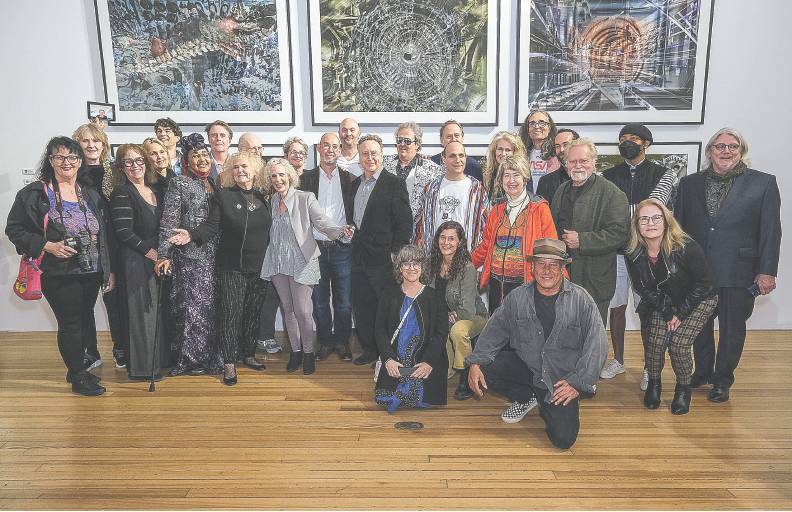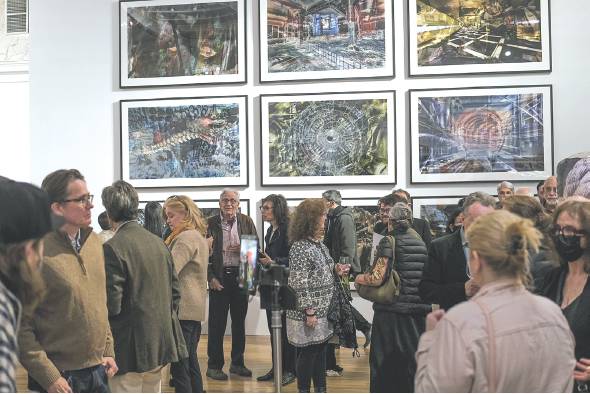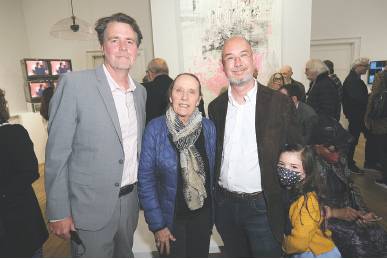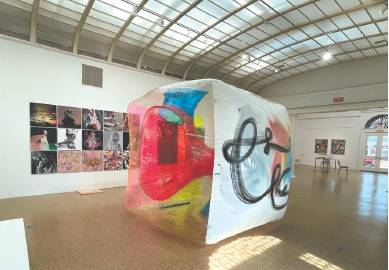An Artistic Movement With Global Reach Has Very Local Roots
SAC’s ‘Techspressionism’ show reveals visions of what art can be
BY ANNETTE HINKLEtechspressionism
/tek-spresh-un-niz-uh m/
1. An artistic approach in which technology is utilized as a means to express emotional experience.
2.A 21st century artistic and social movement.
Back in June 2011, Colin Goldberg had a solo exhibition of his work at Southampton’s 4 North Main Gallery. Goldberg, who was born and raised in Southampton, is a traditional painter, but he also incorporates digital methods into his art as well.
At the time, he was facing a conundrum because he found that the phrases then in common usage to describe art like his were inadequate and inaccurate. As a graduate student at Bowling Green State University
See TECHSPRESSIONISM, Page B4 FROM PAGE B1
in Ohio, Goldberg, who now lives and works in Vermont, noticed that terms like “computer art” or “digital art” were gaining traction, but he notes those descriptions encompassed everything from Pixar films to video games like “Grand Theft Auto” — neither of which had any relationship to his own work.
“I feel like the terms ‘digital’ and ‘new media’ that are used to describe art are describing the technology, but they never actually described work like mine which involves painting,” he said. “It’s traditional media with a digital component, but it’s not digital art.”
He added: “I never felt comfortable calling my art that.” So for that 2011 solo show in Southampton, he came up with a new term for art like his — Techspressionism. He asked art critic Helen Harrison, director of the Pollock-Krasner House and Study Center in Springs, to write a catalog essay for the show, and soon, Goldberg realized he was on to something.
“That was a turning point where I thought maybe it could be a term and more than a descriptor for my own work,” Goldberg said. “Fast forward to the pandemic, I did a Google search and found a Southampton Press article about Oz Van Rosen who referred to herself as an ‘Abstract Techspressionist.’” While Goldberg notes that initially, his wife’s reaction was that Van Rosen had co-opted his term, Goldberg didn’t see it that way. Instead, he reached out to Van Rosen and asked if she would be interested in forming a group of like-minded artists under the Techspressionist moniker. She was, so they did. Goldberg also invited Harrison, Sagaponack artist Steve Miller (for whom he worked as a studio assistant 30 years ago), and fellow artist Patrick Lichty, a friend from BGSU, to join the group, which had its first meet-up on Zoom in September 2020, in the midst of the pandemic.
A movement was born.
“These were the first Techspressionist salons,” Goldberg said. “Now it happens every two weeks online with artists from all over the world. We meet up and talk about where people are presenting their work.
“It’s like in the ’20s and ’30s when the Surrealists held salons at people’s homes and cafés to talk about art and philosophy. We were inspired by that,” he added. “My goal is to bring Techspressionism into common usage. I don’t want it to be a brand that becomes a word. I prefer it to be like Pop Art or Expressionism.”
Like the artists involved in key movements in previous generations, Goldberg felt it was important that the group develop a manifesto to define Techspressionism — just a few lines of carefully considered text that express the philosophical ideology behind the concept.
“I think that Helen’s encouragement and knowledge of Expressionism has helped crystallize what this means to me,” Goldberg said. “She talked about Techspressionism as the next phase of development in Expressionist ideas. Expressionism really predated Pollock.
“I often thought the Surrealists and Futurists had manifestos, an artist-defined dictate, versus the term Abstract Expressionism, which was something defined by critics like Clement Greenberg,” said Goldberg, who wrote the original draft of the Techspressionism manifesto in 2014, which was subsequently revised by artists Patrick Lichty and Renata Janiszewska and finessed by Harrison.
The manifesto defines Techspressionism as “an artistic approach in which technology is utilized as a means to express emotional experience” and Goldberg notes that one of the key contributions that Harrison made to the document was advocating for Techspressionism to be referred to as an approach, rather than a style.
“Calling it an approach allowed both abstract and figurative work, painterly work, intricate deliberate work,” Goldberg said. “It’s the idea of technology for personal expression.”
After that first Techspressionism Zoom meeting in the fall of 2020, Harrison, who became an advisor to the group, suggested an exhibition be organized with a full slate of artists whose work relates to the concept. On April 21, the Southampton Arts Center opened “Techspressionism — Digital & Beyond,” the first such exhibition.
Curated by Goldberg, the show includes work by more than 90 artists from 20-plus countries who utilize technology in creating art with the works on view reflecting the expressive potential of electronic media. The breadth of art on view at Southampton Arts Center is expansive. It’s also diverse — from Michael Rees’s inflatable vinyl cubes that dominate the main gallery spaces, and animated NFTs (non-fungible tokens) that are viewed on video monitors, to Suzanne Anker’s series of plaster, resin and bronze sculptures based on Rorschach tests and more traditional-style wall art pieces, there is a lot to consider. Goldberg has three paintings in the show, including “Kneeling Icon.” The large, digital monoprint has an augmented reality-triggered component in the form of an animated 23-second NFT that viewers can see on the gallery wall when they view the physical work through an app on their mobile device. Also on view is work by pioneering video artist Frank Gillette. In the mid-1960s, Gillette worked for Marshall McLuhan, who coined the phrase “the medium is the message” and also predicted the World Wide Web almost 30 years before it was invented.
Because much of the work is built by artists in a digital space in other countries, Goldberg discovered a creative way to get the work in hand and on SAC’s wall. For example, one installation features a collection of 15 identically sized digital monoprints by artists from Ukraine, Iran, Afghanistan, Russia, France, India, Brazil and other countries, presented in a grid format and printed on squares of aluminum. Goldberg explains that rather than having the artists send physical works, they each submitted a high-resolution image of their piece digitally with authentication verified by DocuSign technology. Goldberg found a vendor in New York City to print the images on aluminum for the show.
The international reach of Techspressionism is quite impressive, given it was a local concept born little more than a decade ago. But it should come as no surprise that Goldberg relied on modern technology to help Techspressionism expand throughout the world.
“I was using a hashtag on Instagram as a way to grow this out,” said Goldberg as he explained how the idea gained traction. “I was tagging people’s work that I thought was a fit with this hashtag. I’d search other tags, like digital art, and see if other artists fit. If someone relates to the idea, it’s free for anyone to say it’s theirs.
“One of the first was artist Davonte Bradley — he goes by ‘Davo’ and lives in Richmond, Virginia,” Goldberg continued. “He’s been a key figure in the ‘movement’— it feels weird to call it that. He’s the monitor of our salons and the face of it. I called him up and had a long conversation. “There’s something important about this,” added Goldberg, who feels like through this effort, he’s found his people. “I’d experienced a lot of rejection from traditional galleries because I used technology in my work. Now two years later, there are 40,000 posts on Instagram using the hashtag. We have 270 or 280 in our artist index from 41 countries. Not all are active in the salons, but there’s a core group who is, and it’s all volunteer based.”
CONTINUED ON FACING PAGE CONTINUED FROM PREVIOUS PAGE
Techspressionism is also launching a series of nodes, which Goldberg describes as artist groups that organize physical shows in their own locations.
“The Iranian node launched a year ago with two female artists, who are both in this show. We also have a French, German and a Canadian node,” said Goldberg, who added that a node must include at least two artists. “The French node is looking to organize a show in Paris. People have to take it and run with it.”
Of course, the irony is that Techspressionism really solidified as a movement only after the arrival of COVID-19. When asked if he thinks the movement would have happened so quickly had it not been for the pandemic, Goldberg responded: “The pandemic contributed to the adoption of Zoom and a lot of the artists wouldn’t have been on digital conferencing otherwise. I don’t think it would exist in the way it does, to be honest. Zoom has been an essential piece, and Instagram, plus NFTs came out shortly after we started rolling.
“After the eighth salon, Davo said why not record and publish these? That was another turning point of the project,” Goldberg said. “It’s a different flavor when you’re recording for posterity.”
The outsourcing of various aspects of Techspressionism to members of the organization — from creating nodes to managing Instagram posts, or recording salons — has been key to growing and managing the movement. In addition to the salons, also available on techspressionism.com are recordings of artists interviews — some 25 of them so far. Inspired by Andy Warhol’s Interview magazine, that initiative was designed and spearheaded by Shelter Island artist Roz Dimon.
While other artists have helped to grow and shape Techspressionism, for Goldberg, having the support and guidance of Harrison in advancing the concept has been key.
“To me, it was a clever term, but I didn’t know what to do with it,” Goldberg said. “She had the ability to guide the direction of the project based on historical artistic precedence of the past. That gave me permission to be legitimate with this.”
As the longtime director of the Pollock-Krasner House and Study Center in Springs — and with experience as an art critic, curator and writer — Harrison is in a position to know when something exciting and new comes along in the world of art. Techspressionism is a concept that she definitely found intriguing.
“It really did tie in with the Expressionism, subjectivity being a primary focus, and the use of materials or techniques available to you to create the content,” Harrison said. “You could say Pollock used house paint and house paint is for houses, not fine art. But if that’s the material he needed, then it is for fine art.”
She also feels it’s significant that Techspressionism is a term that Goldberg is looking to share and offer up to other artists on not just a local, but a global scale.
“If it’s just personal, it’s not a movement. He didn’t want it to be like the doggie in the manger, as if no one else thought about it or could use it,” Harrison said. “What gave it resonance is people expressing themselves in personal, creative and intuitive ways. What’s the point of making it for yourself?
“What’s interesting to me is how many different ways people have employed technology as an expressive tool and not just digital technology,” she added. “I’m a dinosaur, I’ve seen a lot come and go, but I feel like this has a lot of potential.”
“Techspressionism — Digital & Beyond,” is on view through June 4 at the Southampton Arts Center, 25 Jobs Lane, Southampton. For details visit southamptonartscenter.org or call 631-283-0967.





